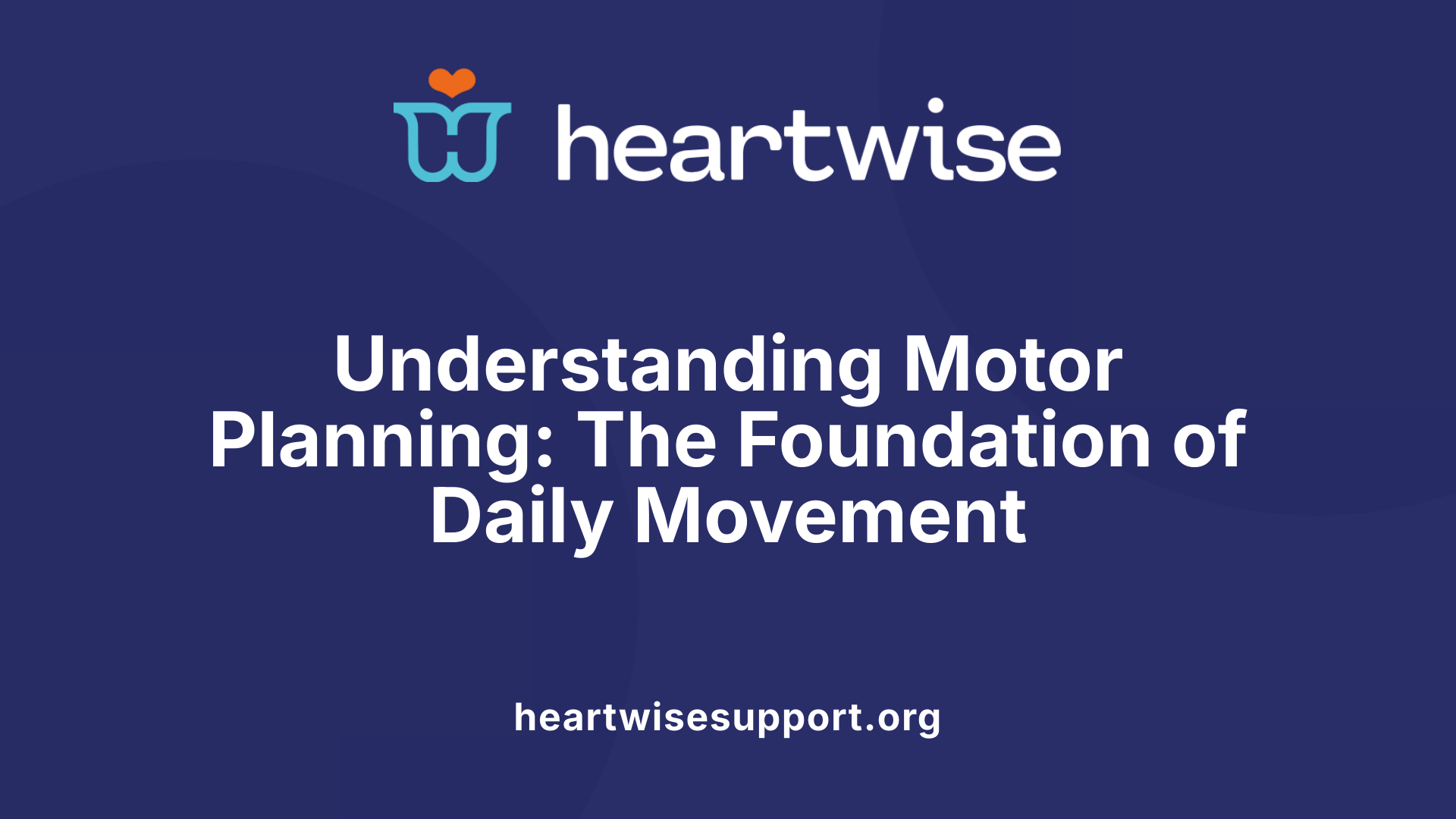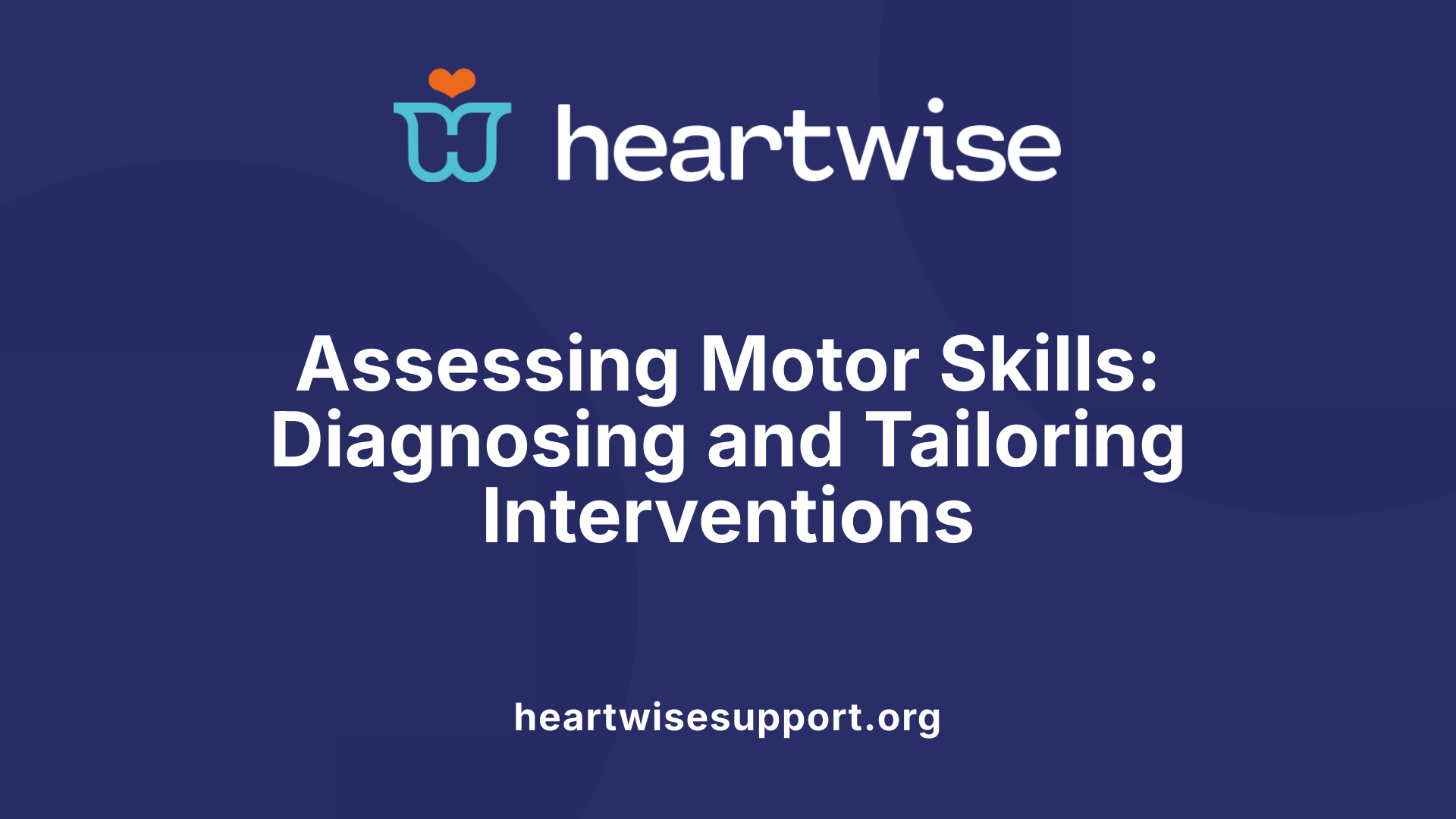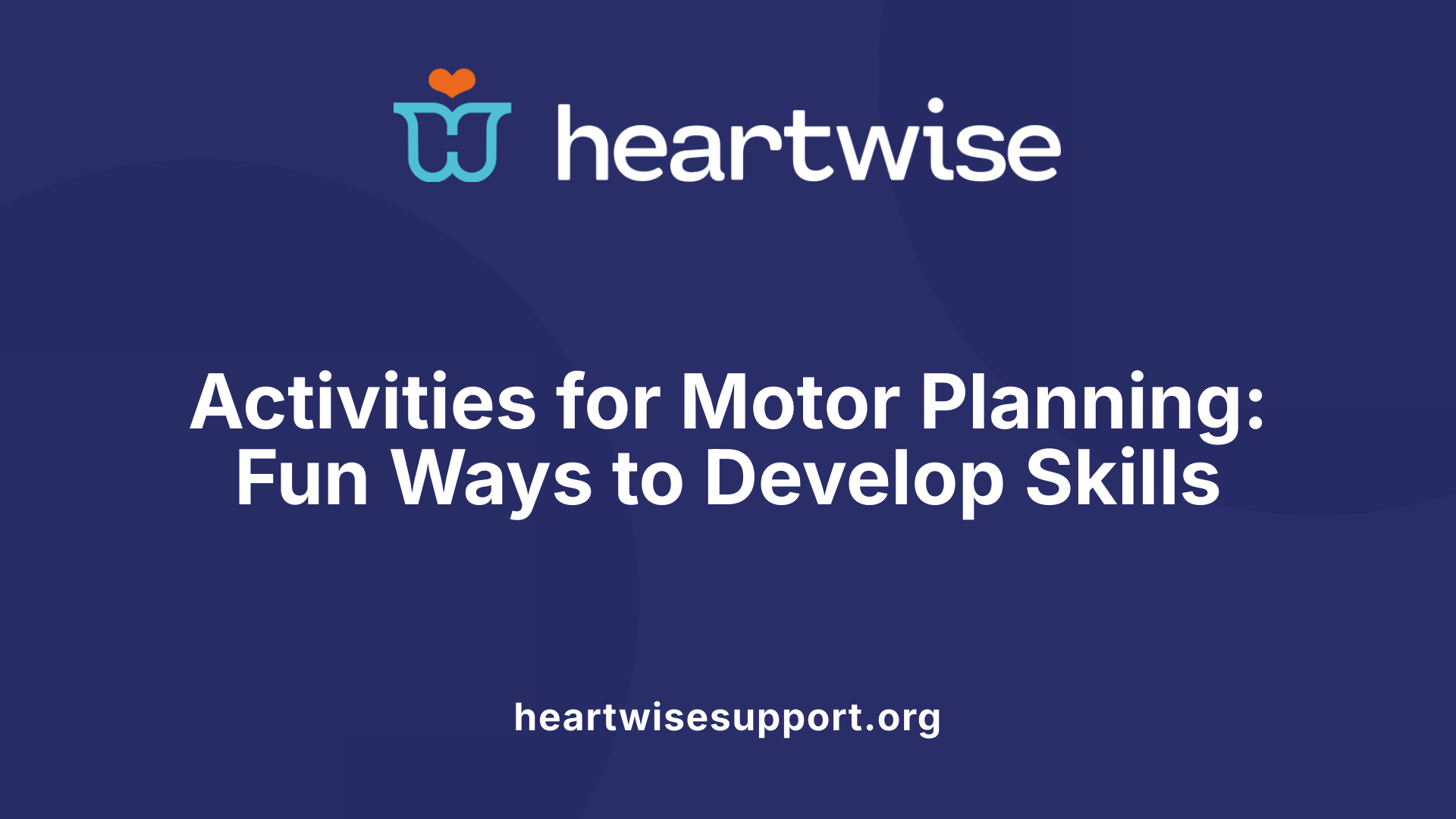Understanding Motor Planning and Its Impact on Daily Life
Motor planning is a fundamental skill that influences a person’s ability to perform everyday tasks efficiently and independently. Central to occupational therapy, motor planning encompasses the ability to conceive, organize, and execute movement sequences necessary for activities ranging from grooming to sports. This article explores the importance of motor planning, signs of difficulties, assessment and diagnosis procedures, and effective intervention strategies used by occupational therapists to enhance these vital skills.
Defining Motor Planning in Occupational Therapy

What is motor planning?
Motor planning, also known as praxis, is a comprehensive process that involves understanding a task, planning the movements needed to complete it, and executing those movements effectively. It encompasses the ability to conceive, organize, and sequence complex body actions, allowing individuals to perform a wide range of daily tasks.
Process involved in motor planning
The process begins with the brain creating an internal idea or concept of the activity. This involves four main components: ideation (the idea of what to do), motor planning (organizing how to do it), execution (carrying out the movement), and feedback (adjusting based on sensory input). Movement involves bones, joints, muscles, and neural messages sent back and forth between the brain and body, ensuring coordinated and purposeful actions.
Occupational therapists analyze these movements to assess strengths and difficulties. They may use activities like obstacle courses, puzzle-solving, or multi-step instructions to observe how well a person plans and performs movements.
Importance for daily activities
Motor planning is essential for routine tasks such as brushing teeth, getting dressed, writing, riding a bike, or playing sports. Difficulties in this area, referred to as dyspraxia, can cause clumsiness, slow movements, or unsafe task execution. Children with issues like Developmental Coordination Disorder (DCD), Sensory Processing Disorder (SPD), or Autism Spectrum Disorder (ASD) may experience motor planning challenges that impact their independence.
Therapists employ various activities to improve these skills. For children, options include yoga, animal walks, and obstacle courses, which help build strength, coordination, and sequencing ability. In adults, interventions might focus on grooming, balance exercises, or manipulative tasks like cooking or handwriting.
By practicing these activities consistently and performing their analysis, clients learn to break tasks into manageable steps, reduce effort, and perform daily routines effectively. Ultimately, strengthening motor planning skills promotes independence and safe participation in everyday life.
Recognizing Signs of Motor Planning Difficulties

What are common signs of motor planning difficulties?
Signs of motor planning issues, like dyspraxia, often include trouble organizing and completing complex movements. A person may appear clumsy, struggling with both fine motor skills—such as handwriting, buttoning shirts, or tying shoelaces—and gross motor skills like jumping, running, or riding a bike.
Developmentally, children might experience delays in reaching milestones such as crawling, walking, or writing. They may also exhibit behaviors like fatigue or frustration during tasks and tend to avoid activities that demand coordinated movements.
Unusual body positions and balance problems are common indicators. For example, a child might walk on tiptoes or have difficulty maintaining posture during activities. Sensory sensitivities—either overreacting or underreacting to touch, sound, or movement—can further complicate their motor responses.
In adults, these difficulties can impact everyday routines such as dressing, grooming, or performing household chores. Academic tasks like handwriting and sports performance may also suffer. Commonly, people with motor planning challenges show signs of low coordination, slow movements, and may bump into objects frequently.
Manifestations in children and adults
In children, signs include clumsiness, delays in motor skill development, and avoidance of physical activities. They may find it hard to follow multi-step directions or organize their body movements smoothly.
In adults, struggles often manifest as difficulty performing tasks requiring coordination and planning, like cooking, cleaning, or participating in sports. They may also report feeling tired after even simple physical routines.
Impact of sensory integration and neural processing issues
Many motor planning difficulties stem from poor sensory integration or neural processing problems. When sensory information—such as proprioceptive or vestibular input—is not processed efficiently, organizing movements becomes challenging.
This can cause difficulties in balancing sensory inputs and executing smooth, purposeful actions. Neural connection issues may also impair the brain’s ability to send and interpret signals necessary for coordinated movement.
Overall, these sensory and neural challenges lead to observable signs like clumsiness, delayed responses, and inconsistent motor performance. Recognizing these signs early allows for interventions that can improve motor skills and daily functioning.
Assessment and Diagnosis in Occupational Therapy

How can occupational therapy assess and diagnose motor planning issues?
Occupational therapists evaluate motor planning, or praxis, by carefully observing how individuals perform everyday tasks that require sequencing, organization, and coordinated movements. This process involves analyzing both the actions themselves and the underlying factors that affect performance.
Therapists often use standardized assessment tools to identify specific challenges. Instruments like the Bruininks-Oseretsky Test of Motor Proficiency (BOT-2) and Miller Function & Participation Scales (M-FUN) provide detailed insights into fine and gross motor skills, while the Sensory Integration and Praxis Tests (SIPT) focus on sensory processing alongside motor planning.
During assessments, therapists observe tasks such as dressing, grooming, handwriting, or engaging in play activities. They look for signs of dyspraxia, including clumsiness, difficulty following multi-step instructions, slow or inefficient movements, and poor coordination. These observations help in pinpointing whether the difficulties stem from issues with neural communication, sensory integration, or muscle coordination.
Understanding the role of sensory processing is also crucial. For example, poor sensory input can impair a child’s ability to plan and execute movements smoothly. By analyzing how sensory factors influence motor performance, therapists can design targeted interventions.
Overall, this comprehensive approach combines visual observation, standardized testing, and sensory evaluation to accurately diagnose motor planning difficulties. The goal is to develop personalized strategies that enhance clients' functional skills, enabling them to participate more fully in daily routines and activities.
What are some typical activities used to evaluate motor planning?
Assessment activities often simulate real-life challenges, allowing therapists to see how clients organize and execute movements. Tasks like complex dressing routines, handwriting exercises, or obstacle courses reveal how well individuals manage multi-step activities.
Additionally, therapists may incorporate specific tasks such as copying shapes, following verbal instructions, or engaging in activities like yoga poses or animal walks. These help assess coordination, sequencing, and problem-solving within movement contexts.
Effective assessment not only diagnoses current abilities but also helps monitor progress over time, guiding intervention planning and goal setting for improving motor skills.
Therapeutic Strategies and Activities

How do occupational therapists use engagement in functional and sensory activities to enhance motor planning?
Occupational therapists often incorporate everyday activities that are meaningful to the individual, promoting functional skill development through practical exercises. These activities might include tasks such as dressing, grooming, using scissors, or preparing simple meals. Sensory activities that involve proprioceptive and vestibular input, like swinging or deep-pressure exercises, help organize sensory information, which is essential for planning and executing movements.
Integrating multisensory experiences ensures that the brain receives varied input, facilitating better motor coordination and planning. For children, games like obstacle courses, animal walks, and Simon Says are used to develop gross motor skills and coordinated movement sequences. Adults may practice yoga, balance exercises, or manipulative tasks like pouring or buttoning to improve their motor planning capabilities.
Why is repetition and practice crucial in improving motor planning?
Consistent repetition reinforces neural pathways involved in motor tasks. Regular practice allows clients to become more efficient at organizing movements, reducing energy expenditure, and increasing confidence in performing daily routines. This repetitive engagement aids in transforming deliberate effort into automatic responses, which is vital for independence.
Occupational therapists often structure therapy sessions to include multiple repetitions of specific activities, gradually increasing difficulty as skills improve. For example, a child may repeatedly practice buttoning or puzzle-solving tasks until these actions become smooth and effortless. By doing so, clients develop stronger, more reliable motor plans that translate into real-world activities.
How are exercises tailored based on individual assessments?
Assessment plays a foundational role in designing personalized intervention plans. Therapists analyze a client’s specific motor challenges—such as poor coordination, difficulty with sequences, or sensory integration issues—and select activities that target these areas.
For children with dyspraxia or Developmental Coordination Disorder, activities like maze bags, pegboards, or multi-step drawing tasks are utilized to enhance both fine and gross motor planning. For adults, therapists might focus on grooming, handwriting, or balance exercises tailored to their functional needs.
Furthermore, feedback from ongoing observations helps adjust activities, ensuring they remain challenging yet achievable. This individualized approach maximizes progress, making interventions more effective and aligning them with clients’ daily life goals.
| Approach | Activities Examples | Purpose |
|---|---|---|
| Functional Task Integration | Dressing, meal prep, grooming | Promote real-world skill application |
| Sensory-Based Techniques | Swinging, deep-pressure exercises | Enhance sensory processing for movement |
| Fine Motor Skill Practice | Puzzles, pegboards, stringing beads | Improve hand-eye coordination, dexterity |
| Gross Motor Development | Obstacle courses, animal walks, jumping jacks | Develop coordination, strength, endurance |
| Multistep and Sequencing Practice | Drawing, following instructions, game activities | Strengthen planning and execution benefits |
Through a combination of these targeted activities, occupational therapists aim to build stronger motor planning capabilities, ultimately supporting greater independence and confidence in daily life.
Activities Supporting Motor Planning Development

What types of activities support the development of motor planning skills?
Developing strong motor planning abilities involves engaging in both gross and fine motor tasks that challenge an individual's ability to sequence movements, coordinate actions, and think through complex steps. For children, activities such as obstacle courses, yoga, animal walks, and dance movements help improve body awareness, coordination, and timing.
Games like "Simon Says" encourage children to follow multi-step instructions and imitate diverse movements, which enhances their ability to plan and execute actions based on verbal cues. For fine motor skill development, activities such as drawing, coloring, manipulating Play-Doh, threading beads, and practicing cutting with scissors are very effective. These tasks help refine hand-eye coordination and finger dexterity, foundational for precise movements.
Balance and spatial awareness are further developed through activities that involve movement and stability, such as sidewalk chalk drawing, catching and throwing balls, and participating in balance exercises or dance routines. Incorporating these activities into daily routines provides meaningful opportunities to practice planning and executing complex motor actions.
Consistency and variety in activities are crucial. Using explicit instructions and encouraging problem-solving during tasks helps children and adults improve their ability to organize movements, break down complex tasks into manageable steps, and adapt when necessary. Overall, these engaging activities not only support motor planning but also make the process fun and meaningful for learners of all ages.
Goals in Occupational Therapy for Motor Planning
What are the goals of occupational therapy related to motor planning?
The primary aim of occupational therapy in addressing motor planning is to improve a person's ability to conceive, organize, and carry out purposeful movements. This encompasses essential skills like sequencing steps correctly, coordinating movements efficiently, and executing tasks smoothly. Achieving these skills helps individuals become more independent in daily routines such as dressing, grooming, writing, and participating in sports or recreational activities.
Therapists focus on tailoring interventions to target specific difficulties caused by conditions like apraxia or dyspraxia, which hinder efficient movement planning and execution. These interventions often involve engaging, functional activities and play-based exercises that support sensory integration and reinforce neural connections necessary for motor planning.
Building confidence and reducing frustration are also key goals. Therapists provide strategies, feedback, and practice opportunities that enable clients to better understand their movements and improve their skills over time. This holistic approach helps clients transfer learned skills to new situations, boosting their overall functional independence.
Ultimately, occupational therapy strives to empower individuals to participate fully and confidently in everyday tasks. This results in enhanced quality of life, greater self-esteem, and improved capacity to engage with their environments through improved motor planning abilities.
Evaluating Effectiveness of Occupational Therapy Interventions
How effective is outpatient occupational therapy for motor skill development?
Outpatient occupational therapy has proven to be quite successful in enhancing motor skills, especially when interventions are specifically tailored to each child's unique needs. Therapists often incorporate engaging activities such as fine motor tasks, visual-motor coordination exercises, and functional daily routines to improve overall motor performance.
Research shows that the number of therapy sessions and the focused activities significantly impact results. For instance, approaches like the Cognitive Oriented, and Performance (CO-OP) method have demonstrated lasting improvements in children with conditions like developmental coordination disorder. These improvements often persist several months after therapy concludes.
Furthermore, programs that actively involve parents and caregivers—training them to support and reinforce new skills at home—tend to yield better, more enduring outcomes. Such involvement ensures that children practice skills consistently outside of therapy sessions, fostering greater independence and confidence.
Overall, when outpatient occupational therapy employs a process-oriented, individualized approach combined with fun, goal-directed activities, children experience meaningful advancements in their motor skills. This structured yet adaptable intervention strategy makes therapy a valuable component in supporting children with motor development challenges.
Understanding the Components of Motor Planning and Praxis
What are the components involved in motor planning and praxis skills?
Motor planning and praxis involve several interconnected components that enable a person to perform complex movements effectively. These components include:
- Ideation: The process of generating and conceptualizing an idea or plan for a movement or task.
- Planning: Organizing and sequencing the necessary steps to carry out the movement, considering spatial and temporal aspects.
- Execution: Performing the planned movements using muscles, joints, and bones.
- Feedback and Adaptation: Monitoring movement performance via sensory input and feedback, then adjusting actions as needed for improved accuracy and coordination.
Together, these phases form a continuous cycle that supports goal-directed actions. Sensory information, such as touch and proprioception, heavily influences planning and adjustments, as they provide essential data about body position and movement effects.
Repetitive practice and sensory integration are foundational to strengthening these skills. Occupational therapy often employs targeted activities to challenge and develop each component, fostering better coordination and functional independence in daily routines.
Praxis, as a broader concept, encapsulates the entire process—starting from idea conception, through planning and execution, to ongoing feedback and refinement. This seamless flow enables individuals to adapt movements across various situations, ensuring effective participation in everyday activities.
Managing Conditions Like Somatodyspraxia Through Occupational Therapy
How does occupational therapy help manage conditions like somatodyspraxia?
Occupational therapy (OT) plays a vital role in supporting individuals with somatodyspraxia, a condition characterized by difficulties in motor planning and coordination. Therapists develop personalized intervention plans that target a child's specific motor and sensory challenges. These plans often include activities designed to improve praxis—the ability to conceptualize, organize, and carry out complex movements.
A core component of OT is sensory integration therapy, where children participate in play-based activities like swinging, bouncing, or brushing to help regulate sensory responses. These activities promote better sensory processing, aiding children in responding more appropriately to their environment.
OTs also incorporate specific exercises and tools, such as obstacle courses, fine motor tasks like puzzles or pegboards, and balance games, to enhance motor planning skills. Collaboration with families is essential; therapists provide guidance on implementing sensory diets—structured activity plans that include calming or alerting sensory inputs—as well as behavioral techniques to foster independence.
Through these tailored strategies, individuals can see improvements in motor skills, daily functioning, and behaviors. Regular occupational therapy, especially when initiated early, can lessen symptoms of somatodyspraxia and lead to increased confidence, safety, and independence in everyday life tasks.
Empowering Independence Through Targeted Therapy Strategies
Occupational therapy plays a pivotal role in addressing motor planning difficulties across all age groups. Through comprehensive assessment, evidence-based interventions, and engaging activities, therapists help individuals develop and strengthen the skills necessary for daily independence. Tailored strategies not only improve motor coordination and sequencing but also boost confidence, allowing clients to participate fully in personal, academic, and recreational activities. As research continues to support effective therapies, the ultimate goal remains to empower individuals with motor planning challenges to lead more autonomous and fulfilling lives.
References
- What is Motor Planning - The OT Toolbox
- Occupational Therapy Motor Planning Examples, Goals, and Activities
- 5 Therapist-Approved Motor Planning Activities | NAPA Center
- Praxis & Motor Planning | Gross Motor | Therapy Resources
- Effectiveness of Outpatient OT Interventions to Improve Motor Skills ...
- How occupational therapists help kids who struggle with motor skills
- Praxis and Motor Planning in Occupational Therapy - NAPA Center
- Occupational Therapy for Sensory Processing Disorder - ASD Clinic
- Sensory Integration Therapy in Paediatric Rehabilitation - Physiopedia











